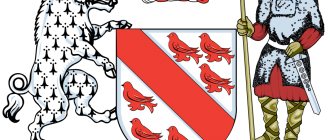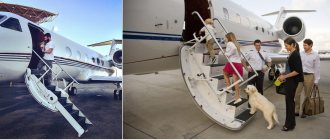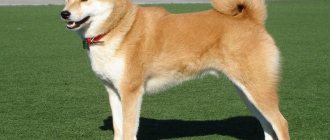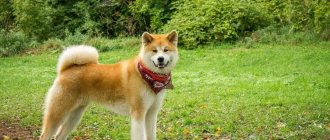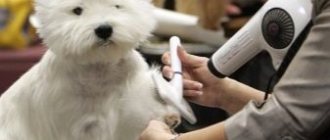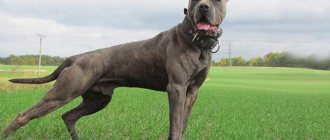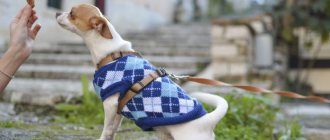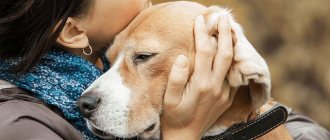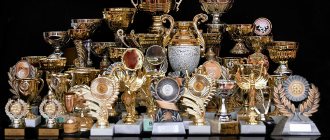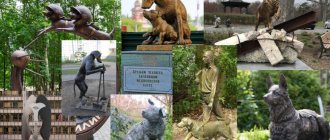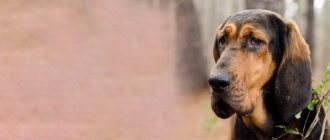Many dog lovers know that the Tibetan Mastiff is considered the most ancient breed and the progenitor of many dog breeds.
However, there is another little-known breed, which, as a result of recent research, can claim to be the oldest.
This is a Buryat-Mongolian wolfhound or Khotosho. She is poorly known among non-professionals. Let's talk about this dog, what it looks like, where it came from, whether it can be kept at home and learn other interesting facts.
Photo: wikimedia.org
Characteristics and breed standard
Height at withers: males – 74 cm and above, females – 66 cm and above.
Weight: not included in the standard.
Color: black with red tan. Zoned gray color, solid brown and red coat color are allowed. There may be small white spots in the area of the chest, tip of the tail and all limbs with an even distribution.
Eye color: brown and its variations.
Nose color: not included in the standard.
General appearance: a massive dog with a strong build, coat of any length, but a thick undercoat. Volumetric head and wide muzzle, drooping ears. Movements are free.
Description
The standard positions the Bankhara as a guard, guard and security dog. These animals are used as bodyguards and simply companions, and are also taken with them on hunts. They are used in various emergency situations, for searching for missing people, and even in law enforcement service.
Appearance
Khotosho is a very large, athletic, powerful animal of rough constitution with heavy massive bones and well-developed prominent muscles. The body is of a slightly elongated rectangular format with a rounded, deep, widened sternum, a straight, strong back, clearly visible withers, a somewhat convex, not too long loin and a moderately tucked belly. Sexual dimorphism is clear, females are much smaller and lighter than males.
Bankhar has a very large, powerful and massive physique
Breed standard:
- Height at withers: females - from 66 cm;
- males - from 74 cm.
The wolfhound moves in a measured, leisurely manner, sweepingly and freely. The jumping trot is considered the characteristic and preferred gait, and when accelerated it turns into a gallop. All movements are elastic and springy, while the topline remains straight.
The coat is thick, straight, hard and rough to the touch with a densely packed soft undercoat. Shorter and tighter hair on the head and front of the legs.
The standard distinguishes three types according to coat length:
- Short-haired. The dog's body is evenly covered with short and very thick hair with dense, well-developed down. During the cold season, the undercoat grows longer than the main hair.
- Long-haired. The guard hair is of considerable length. The long coat forms trousers (feathers) on the limbs and a characteristic mane on the neck. The tail is covered with elongated hair on all sides.
- Intermediate. The outer coat is of medium length. On the tail there is a dewlap of elongated hair (on the lower part), a slight and not very pronounced, beautiful coat (mane and trousers).
The hotosho coat, the main protection against external influences, copes with this task perfectly, protecting the dog from any precipitation: from rain to snow. In addition, the correct coat has a tendency to self-clean - foreign impurities from thorns to clay easily slide off it.
Another feature is the tendency to intense seasonal shedding, when even a long-haired dog looks short-haired if you do not pay attention to the dewlap on the tail.
Extract from the standard
The following colors are allowed:
- black and tan (basic) with very light, almost white to copper markings;
- zoned-tan;
- red (from rich and bright fiery red to diluted fawn);
- black.
White spots on the chest, tail (tassel), and lower legs are acceptable.
In the warm season, during molting, the wool from the bankhar comes off in layers
Disadvantages and disqualifying vices
Minor defects or deficiencies are considered:
- height deviations: females - up to 64 cm;
- males - up to 72 cm.
The following are recognized as defects or serious deficiencies:
- small stature: females - less than 64 cm;
- males - less than 72 cm.
The reasons for disqualification will be:
- color spotted or piebald;
- cryptorchidism;
- overshot, undershot, absence of incisors, premolars (except the first), canines, molars (first and second);
- Blue eyes;
- ambling movements (unilateral rearrangement of limbs).
Character and psyche of the breed
Despite its impressive dimensions, Khotosho has a cheerful and cheerful, pronounced sanguine temperament . He is mobile, easy-going, full of energy and permanently self-confident. The dog is curious, always carefully watching everything and everyone. This quality makes him an excellent guard, reliably guarding the territory and property entrusted to him. He perceives strangers with caution and distrust, but does not show any aggression until he sees a real danger emanating from them. In this case, he is able to make independent decisions and act decisively.
Khotosho is always on the alert and vigilantly guards the territory entrusted to him
The Tibetan wolfhound is peace-loving and very balanced; in principle, he is not inclined to enter into conflict situations, trying to the last to simply scare the enemy . But if necessary, he is quite capable of defending his honor. He gets along well with all pets, seeing them as a ward flock in need of protection and care. Banhar becomes strongly attached to all family members, showing boundless devotion. He treats children of all ages very carefully, allowing and forgiving them many pranks.
Since ancient times, Buryat-Mongolian wolfhounds have played the role of nannies for the master's children, who were quietly left in the care of the dogs. The huge animal did not allow the children to stray far from home, standing in the way and gently pushing them with its body in the right direction. There have been many cases on the water when they wanted to control swimming human offspring, not giving them the opportunity to swim beyond a certain safe border.
History of the Buryat-Mongolian wolfhound
The historical habitat of these dogs is the territory of modern Buryatia. They lived for centuries among nomadic tribes, taking on the functions of guards . Wolfhounds were also trusted by small children to guard them. Their physical characteristics allowed men to take them hunting . However, unlike the almost universal Caucasian Shepherd Dog, Buryat-Mongolian wolfhounds were not used to herd livestock. It is believed that they served in Buddhist monasteries.
Today, there is debate about the true origins of the modern stock. However, even based on the results of archaeological excavations, it can be assumed that the Buryat-Mongolian wolfhounds are descendants of an ancient breed group.
Local tribes who profess Buddhism treat dogs as sacred creatures. Therefore, wolfhounds were allowed into a person’s house. There are a lot of legends and beliefs associated with them.
For example, their ancestor Sarama was the assistant of God Indra. She had a black and tan color, which is popularly called “four-eyed” because of the red spots on her forehead. Since then, the Buryats believe in the divinity of dogs of this color, bringing happiness to the entire tribe. According to another legend, such a “four-eyed” dog asked the angry Buddha to leave some grains on the ears and saved humanity from starvation.
Buryat-Mongolian wolfhounds are an indigenous breed. Man has only an indirect relation to its formation. All skills were formed over a long period of time; people only made selections based on working qualities, leaving the strongest with adequate behavior.
By the beginning of the 20th century, wolfhounds from Buryatia became small in number, but already in the second half of the century, factory breeding and restoration of the breed began. Nikolai Batov was involved in the revival. In the 80s of the last century, he removed several representatives of the breed from their natural habitat and settled them in his nursery for further breeding and increasing the population.
The modern canine society, represented by the RKF, recognized the breed group Buryat-Mongolian dog in 2000. Breeds are working towards international recognition in the FCI system, which requires a certain number of dogs with similar appearance, temperament, behavior and the known origin of several generations of progenitors from official pedigrees.
The Buryat-Mongolian wolfhound (BMW) has several names: Mongolian Shepherd Dog, Bankhar, Hun Dog, Tibet, but Buryats often use it as “ hotosho” . The meaning of this word translated from the Mongolian language is “yard dog” , “yard wolf” .
Price and where to buy a puppy
An animal with excellent working qualities, which is the bankhar, is quite expensive. The cost of a puppy varies from 65,000 to 150,000 rubles. Such a high price is due to the low prevalence of the breed. But she is increasingly winning the hearts of dog breeders in Russia.
You need to be careful when buying a puppy. This should only be done in a specialized nursery. On the market you can find representatives of the breed that are much cheaper, but such a huge dog with an unstable psyche, bred outside a breeding kennel, can cause harm to its owner.
When buying a puppy of this breed, the owner is faced with an unexpected question - a nickname . After all, it’s quite difficult to come up with a name for such a thug, even with a calm temperament. In addition, the nickname that can be given to a fluffy, clumsy bear cub may not be at all suitable for the formidable guard that he will soon become.
What nicknames can you suggest? These are unlikely to be simple names such as Sharik or Druzhok. Fashionable ones - Amethyst, Baron - will not work either. The name of such a dog should reflect its ancient origins and sound serious. For example: Chingiz, Zavgar, Terra, Elba, Khatis, Hadisa, Khan, Hannah, Sheik and others.
In any case, the choice of nickname is up to the owner; often the name “comes” after the first meeting with a friend.
A killing machine growing? #hotosho #wolfhound pic.twitter.com/Z67rpVjPd5
— Photo from Ulan-Ude (@InstaUlanUde) March 19, 2016
Behavior and temperament
Positive qualities of BMW:
- Equilibrium,
- Absence of unmotivated aggression,
- Devotion,
- High level of intelligence,
- Unpretentiousness,
- Innate protective qualities.
Negative qualities:
- Waywardness,
- Excessive independence.
BMWs are essentially sanguine. They are not characterized by sudden changes in behavior and mood.
Who should start a hobby?
BMWs are not suitable for beginners in cynology, with rare exceptions. Do not become a full owner of a child either. They require an individual approach to education. Wolfhounds get along best with people who know how to show authority.
These dogs are not suitable for athletes . It is important for BMWs to be useful, so it is advisable to set them on security. In addition, the natural talents of a watchman will manifest themselves with age.
Wolfhounds mature late; physical development, along with psychological development, ends after 3 years. They should not be expected to perform productive work until they reach the specified age.
In the city, such a pet will feel good if it is provided with long walks at a leisurely pace and properly socialized. He treats family members without aggression and behaves carefully with children. He recognizes other domestic animals as the property of the owner and considers it his duty to protect them from danger.
Character and behavioral characteristics
A feature of the breed is the late maturation of individuals. The animal becomes fully formed psychologically only by the age of three. Males mature later than females. But this does not prevent them from performing their basic functions at a very young age. Even the smallest puppy will protect its territory, its owner and his family members.
You need to understand that the wolfhound is very human-oriented and it will not be enough for him to see his owner only during feeding and walking. He needs mandatory daily communication, play and affection from a person.
These hulks, whose height on their hind legs is comparable to the height of an adult, love children very much and treat them with caution and emphatic respect.
The dog's character is such that he can hardly tolerate strangers. But he will never rush without a clear reason and warning. They have a very stable psyche, but they are not phlegmatic. Show appropriate aggression when necessary.
Photo: wikimedia.org
Maintenance and care
Khotosho tolerates frost, precipitation and summer heat well. Naturally, when living on the street, it is necessary to build an enclosure with a wooden booth inside and a canopy. Such dogs rarely go indoors unless they are trained to do so. Even in snow storms they prefer to sleep outdoors. Their thick undercoat helps maintain optimal body temperature and prevents moisture from reaching the skin.
The BMW diet consists of foods that are common for dogs:
- Beef or chicken meat and offal (most of the serving),
- Cereals (buckwheat, rice),
- Vegetables in small quantities (exclude tomatoes),
- Cottage cheese, kefir, fermented baked milk, whey,
- Sea fish (rare),
- Chicken and quail eggs.
BMWs have not been observed in mass manifestations of food allergies. You can give treats in the form of large bones with cartilage, frozen tripe, dried liver, pieces of lung, chicken heart.
Large dogs need mineral supplements, which do not exclude vitamins. Natural products that help maintain healthy joints and ligaments include gelatin and cartilage.
The dog is fed either after a walk or active games, or 1.5-2 hours before going out. Otherwise, there may be intestinal volvulus. Feeding puppies depends on age. So, until 4-5 months, the baby is served food several times a day, at least 4 times. By 9 months, 1-2 daily servings are left.
Pedigree wool of various lengths is rough to the touch and should not resemble cotton wool. This type of cover does not require special care. You can wash it with dog cosmetics if necessary, but BMW's coat is self-cleaning. During the molting period, they actively shed old fur, which indicates the need for frequent combing with a comb and slicker. BMW haircut is not advisable.
At BMW, conscientious breeders remove dewclaws without fail. The procedure for their removal is carried out in the first days of the puppy’s life, when the dewclaws are supported by cartilage and there are no large vessels in them. The wounds are treated with brilliant green or other disinfectant.
If an adult dog has dewclaws, surgery takes place under general anesthesia. If you decide to leave the fingers, then you need to carefully monitor the claws on them and promptly shorten them with a special nail clipper for dogs.
Feeding
The breed is very unpretentious in nutrition. You can feed both natural products and prepared foods. Interestingly, most breeders of the breed choose natural nutrition.
Rules for creating a natural diet:
- The share of meat products is 2/3 of the daily diet;
- Choose lean meat: beef, turkey, chicken, offal;
- Cereals are mixed with the meat;
- The diet includes boiled sea fish;
- Sour milk - low fat content;
- Vegetables can be anything. The exception is tomatoes;
- You can give a raw egg twice a week.
It is necessary to strictly monitor the serving size. In addition, you need to follow the feeding rule regarding the walk: an hour and a half before the walk and no earlier than an hour and a half after it. Otherwise, the dog may be at risk of gastric volvulus and will require surgical intervention.
As for ready-made dry food, there are special requirements for it: the food must be premium class, designed for large dogs, and preference should be given to holistic food.
Photo: ytimg.com
Training
City BMWs must complete a general obedience course (GOC). The breed is late in maturity; lovers of service dogs (German and East European shepherds, Giant Schnauzers, etc.) find Mongolian aborigines slow and disobedient. In refutation, breeders point to the peculiarities of the nervous system of their pets.
BMW tends to make decisions independently , which is due to its origin and centuries-old traditions of being kept by nomads. It is important to establish contact with the dog, to become its leader in order to achieve unquestioning obedience coupled with trust.
When undergoing training for guard and protective service, Khotosho show excellent results. Legislation equates a dog with such skills and size to a weapon, therefore, before training, the stability of the dog’s psyche and the ability to control the pet are checked.
Health and life expectancy
BMWs live 12-14 years and are long-livers in their weight category. They have good health and immunity to infections. Most diseases are related to the musculoskeletal system; there are problems with the digestive system, as in all large dogs. The following common diseases are identified:
- Hip dysplasia (HJD),
- Cataracts, lens opacities,
- Intestinal volvulus.
To prevent THD, it is recommended to keep muscles toned by walking in the fresh air over rough terrain and swimming in ponds. Jumping over obstacles and running on ice are contraindicated for puppies, sick and injured dogs. Walking on loose snow develops the muscles of the chest, neck and back.
You cannot raise a puppy in a house with slippery flooring (laminate, linoleum, ceramic tiles). This affects the animal’s joints and ligaments and increases the risk of sprains.
Education and training
Such a dog is not suitable for a person who is just beginning to learn the basics of education and training. This is a very psychologically serious dog. At the same time, it is a very simple animal. Teaching him basic commands will not be a problem.
However, in the matter of education and training, one must be guided by the basic principles: patience, consistency, and physical force must not be used. You shouldn’t give in if the owner has banned something – it’s forever. You cannot give in, but it is also not permissible to insist on your position by force. Plus, it can be downright dangerous. You need to start raising a puppy as soon as it gets into the family.
???❤ #Hotosho #Chuck #dog pic.twitter.com/uAsYFWgGgD
— Anita Tsoy (@anitatsoi) January 27, 2022
